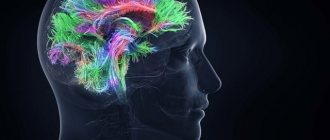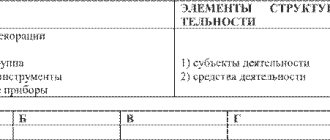Senestopathies (Greek koinos - general, aisthesis - feeling, sensation, pathios - suffering, disease) are pathological sensations, the development of which is not associated with somatic disorders and external influences on sensory organs. The following terms are also used: co-anesthesia, sensations, psychosomatic sensations, somatic hallucinations, somatoform disorder, bodily illusions, dissomesthesia. Described by E. Dupre and P. Camus in 1907. The diagnostic criteria for senestopathy are as follows:
Polymorphism is an extreme variety in which almost all modalities of sensations are represented, as well as numerous submodal sensations. Patients themselves prefer to call them “pains”, although, strictly speaking, senestopathies themselves are very often not pain, this is easily clarified during targeted questioning. Quite often, patients continually change the description of senesthopathy, as if they could not find their exact verbal formula. Often the same patient presents with different senestopathies;
| | Our psychiatric clinic will help you cope with sensoropathy |
Unusual, sometimes very strange, pretentious nature of sensations , which sharply distinguishes them from natural painful sensations caused by somatic pathology. The impression of unusualness is largely due to the fact that the location, projection, configuration and interpretation of senestopathic sensations are very different from what is usually reported by somatic patients. Along with senestopathies, patients may present quite typical complaints of a somatic nature; this circumstance indicates the preservation of the normal process of sensation formation. At the same time, many patients describe ordinary somatic complaints in a rather strange way. The latter circumstance requires caution in assessing the somatic complaints of patients;
The painful affective tone of senestopathic sensations . This is manifested, firstly, by the fact that senestopathies are often a source of extreme suffering for patients, sometimes leading to suicidal thoughts. There are cases when, according to patients, they have never experienced anything more painful in their entire lives. Secondly, various fears are often associated with senestopathies, for example, fear of serious illness, madness, or death. This long-known fact was called “fear in the head” by German authors;
The persistent, seemingly persistent, persistent or even haunting nature of senestopathic sensations . It seems to patients that senestopathies have the ability to forcefully attract their attention. In other words, patients are thereby describing the symptom of painful reflection;
Depressed mood , usually accompanying senestopathies. Depression predominates, combined with anxiety and fears. Depressed mood, meanwhile, is not always recognized by patients. Typical of most of them is a tendency to psychologize their condition. In the minds of such patients, the cause of depressed mood is exclusively senestopathies:
“What kind of mood can you be in when it hurts?” It is often possible to observe that the dynamics of senestopathies are parallel to mood swings. In particular, senestopathies can occur in attacks, accompanied by panic. Such senestopathic attacks are more often regarded as a manifestation of affective pathology, i.e., panic attacks. Cases of mania with senestopathies are very rare;
The uncritical nature of patients , who usually believe that senestopathies, even the most unusual ones, are a sign not of a mental illness, but of some kind of somatic, sometimes serious, disease. Sometimes there are patients with senestopathies and thematically associated delusions of somatic disease;
The area of sensitivity in which senestopathies develop is somesthesia. Painful phenomena in exteroceptive modalities of sensation similar to senestopathies are unknown. In other words, such cross-modal relationships in which the painful qualities of interoreception would be reflected in disturbances of exteroreception apparently do not exist.
There are different approaches to systematizing senestopathies. One of them is anatomical. Thus, A.K. Anufriev (1979) distinguishes the following five types of senestopathies: cardiovascular, central neurological, abdominal, musculoskeletal, and skin-subcutaneous. The author notes that senestopathies localized in the head and heart are especially common.
This approach, and this is where its undoubted advantages lie, is most acceptable in cases of senestopathies with persistent and specific localization. Perhaps it also reflects the point of view according to which senestopathies are somehow related to current or previously occurring somatic pathology. In addition, we cannot exclude the possibility that the localization of senestopathies to a certain extent reflects the patients’ opinion about the significance of the functions of certain organs for him, i.e., it emphasizes the role of psychological factors in the genesis of senestopathies. Some observations have shown, for example, that the localization of senestopathies in the genitals is prognostically unfavorable.
Another approach to systematizing senestopathies is associated with a clinical-psychopathological assessment of the latter. The central idea of this approach is that the severity of the lesion in senestopathies can be established by signs indicating their place in the well-known scale of productive mental disorders, which was presented by A.V. Snezhnevsky in 1983. According to this scale, the severity of a particular symptom is determined by the structure of which syndrome this symptom is included in (it is included and thereby modified in one way or another, and does not simply accompany the main psychopathological syndrome).
Meanwhile, a number of researchers have established that in senestopathies signs of depersonalization, delusions, hallucinations, phenomena of mental automatism and even paraphrenia can be identified (Ushakov, 1973; Ostroglazov, 1975; Eglitis, 1977; Anufriev, 1978; Guteneva, 1979, 1980; Basov, 1980, etc.). Thus, it becomes possible to systematize senestopathies depending on how deep the brain damage that gave rise to them is. This approach forms the basis of this description of senestopathies. The following types of senestopathies will be mentioned: simple, psychosensory, interpretive, hallucinatory and paraphrenic.
Treatment of senestopathy
Diagnostic measures involve collecting a complete and high-quality medical history, as well as complaints and additional studies. It is important to distinguish between senesthopathy and other somatic diseases. If a disease of the internal organs develops, then the distinctive feature will be a feeling of a certain localization and relationship with the position of the organ. Typically, the following types of examinations are carried out:
- MRI
- Ultrasound
- CT.
Symptomatic treatment for senestopathy does not bring the desired results. To stop the disease, analgesics and physiotherapeutic measures are used. Psychologists may be assigned to work to alleviate mental disorders. If the patient suffers from depression or neurosis, antidepressants, antipsychotics and tranquilizers may be prescribed. Psychotherapeutic measures also help reduce the manifestations of the disease.
Description of senestopathies
Senestopathies are unpleasant, painful, sometimes painful sensations in different parts of the body. They can be localized both externally and in internal organs and reach such a degree of severity that they become unbearable. Many patients describe the physical suffering caused by senesthopathy as more severe than physical pain.
In fact, these are only the patient’s own experiences; in reality, no pathologies are found at the site of the sensation. Senestopathies are a consequence of disorders in the functioning of the brain and psyche. These conditions are caused by changes in the functioning of the central nervous system, brain, and mental disorders. Senestopathies can also occur with various neuroses, manic-depressive psychosis, oneiric syndrome, paranoia, hypochondria and some other mental disorders.
Symptoms of senestopathy
The symptoms of Senesthopathy are characterized by a large number of different painful sensations that are not localized. When trying to describe feelings, he cannot clearly define where it hurts and in what intensity. Often, experts observe a strong emotional coloring: painful and painful sensations. It is important to note that some patients report emotional distress rather than physical distress. They constantly concentrate on possible painful sensations, unable to be distracted by another subject.
Another difference is the unusual projection. The patient often indicates pain in a place where, according to medical indicators, there should not be pain. Most often, unpleasant sensations manifest themselves in the form of headaches, less often in the chest, heart and limbs. Senesthopathy can occur periodically or on an ongoing basis, sometimes manifesting as attacks.
results
Lexico-semantic groups (LSG)
. Component analysis showed that the lexical composition of statements is formed based on a relatively small number of classifying concepts, according to which it was possible to identify seven LSGs. Each completed utterance included, as a rule, words from two or three groups. In table Table 2 shows the names of the identified LSGs with explanations and examples of patient statements.
In the comparison group, pathological sensations were described mainly using the words LSG pain (78% of cases) and pressure
(50%).
These patients rarely used words from the groups burning
and
shape
(15 and 17%, respectively) and even less often - concepts belonging to the groups
volume
,
density
and
movement
.
Unlike the comparison group, patients in the main group actively used all 7 LSGs in their statements. Moreover, words belonging to the pain group were found significantly less frequently (only in 23% of cases; p
<0.001) than characteristics of sensations based on the categories
pressure
(57%),
shape
,
movement
(30% each, respectively) and
burning
(25%).
The frequency of use of the concepts of various LSGs in mental patients did not depend on their nosological affiliation, with the exception of a single group - burning
.
The dominance of the burning
directly correlated with the leading affective pathology and localization in the trunk and skin-subcutaneous area (
p
<0.05 in comparison with organic disorders;
p
<0.01 - with patients with schizophrenia;
p
<0.001 - with the control group ). In schizophrenia, senestopathies were located predominantly in the trunk and head. In case of affective pathology - mainly in the torso. In organic disorders, no significant differences in the localization of senestopathies were identified.
Thematic series.
Based on the severity of the protopathic component of pathological sensations, using the unifying function of component and cluster analysis (Fig. 1), seven LSGs were reduced to two thematic series:
hyperpathic
(groups pain, burning, pressure) and
parapathic
(groups volume, density, shape, movement).
Figure 1. Dendrograms of the distribution of seven LSGs in the main (a) and control (b) groups.
On the abscissa axis - LSG: 1 - pressure; 2 - movement; 3 - shape; 4 - density; 5 - volume; 6 - burning; 7 - pain. The ordinate axis shows the closeness of connections between variables. The term “hyperpathic” reflects both the strengthening of certain aspects of bodily self-perception, and the vital undifferentiated affectivity inextricably linked with pathological sensations. Lexical units of the parapathic thematic series describe the physical properties of external objects, which reflects the specific transformation of pathological sensations acquiring qualities that bring them closer to the perceptual level of feeling. The subjects of both groups used primarily words of the hyperpathic thematic series in their statements. However, patients in the main group described pathological sensations using parapathic vocabulary significantly more often than patients in the control group ( p
<0.001). The schizophrenia subgroup differed from the other subgroups in the relatively lower frequency of use (as a percentage) of hyperpathic thematic words in statements (Table 3).
It should be noted that the results of our work correlate with the data obtained in a psychosemantic study conducted by A.Sh. Tkhostov [29], according to which patients with schizotypal disorder significantly more often use “extraceptive” signs in describing pathological bodily sensations ( parapathic
thematic series), and patients with schizotypal and somatoform disorders are characterized by a significantly less frequent use of “specific physical symptoms” (
hyperpathic
thematic series), in contrast to somatic patients, in whom “intraceptive vocabularies... are more real and specific.”
Sensopathic syndromes.
At the next stage of the work, the obtained verbal characteristics of senestopathies were correlated with the clinical picture of the disease, which took into account only the manifestations of the sensoropathic circle: somatopsychic depersonalization, sensory automatisms and visceral hallucinations.
In addition, the factor of completeness of clinical completeness of these syndromes was taken into account, i.e. Senestopathies were distinguished in the structure of rudimentary and formed sensoropathic disorders. In accordance with this, senestopathies identified as a monosymptom of pathological bodily sensitivity, or isolated
senestopathies, and senestopathies that were included in complex sensoropathic syndromes, or
transitional forms
of senestopathies, were analyzed separately.
A comparative analysis showed that isolated
senestopathies were less common (in 45% of statements) than
transitional forms
of senestopathies (in 55% of statements; χ2=4.4;
p
<0.05). The predominance of the latter turned out to be most characteristic of patients with schizophrenia, in whose clinical picture they were detected in 83% of cases.
In addition, senestopathy in the structure of depersonalization disorders occurred much more often than sensory automatisms or visceral hallucinations - 66, 14 and 20%, respectively. Finally, the inclusion of senestopathies in complex sensoropathic syndromes depended both on the clinical forms of the latter and on the degree of their clinical maturity: senestopathies were found much more often in the structure of mild forms of depersonalization than in severe depersonalization syndrome. With sensory automatisms, the vast majority of senestopathies turned out to be included in the structure of a clinically completed syndrome, and with visceral hallucinations, the differences in the frequency of occurrence of completed and immature clinical variants turned out to be statistically insignificant. However, pathological sensations during visceral hallucinations, in contrast to all other cases, were more often described using parapathic thematic vocabulary, regardless of the degree of their clinical differentiation (Table 4).
When comparing the descriptions of isolated and transitional forms of senestopathies, it turned out that among the former there are significantly more descriptions with hyperpathic characteristics of sensations - 89.9% versus 79.1% (χ2 = 4.2; p
<0.05).
Among transitional forms of senestopathies, parapathic characteristics of sensations were more common (61.9%) than with isolated senestopathies (47.7%; χ2=4.5; p
<0.05). The inclusion of senestopathies in complex sensoropathic syndromes and the use of only parapathic words to characterize sensations turned out to be their distinctive quality in schizophrenia. The combination of senestopathies with clinically incomplete sensoropathic phenomena is a distinctive quality of affective disorders and schizophrenia (Fig. 2).
Figure 2. Characteristics of sensopathy in the studied subgroups of patients. On the abscissa axis - sensopathy: 1 - schizophrenia; 2 - affective disorders; 3 - organic disorders. The y-axis is % of statements.
Model
Semantic analysis of complex, varied meanings in speech utterances during senestopathies allows us to reduce them to the simplest components of meaning, which boil down to indicating 1) the reality of existing suffering and 2) a latent threat emanating from an altered bodily self-perception. Changes in the somatopsychic “I” that cause mental suffering (grief, sadness, melancholy, etc.) are transformed into descriptions of physical sensations (pain, burning or pressure). One of the possible directions for the development of the pathological process may be the way of describing suffering in the categories of the patient’s ideas about pain (pain is “physical or moral suffering”). In the patient’s mind, his own body acts as a carrier of a hidden threat and a “tormentor,” predetermining the predominantly bodily, sensoropathic modality of suffering and, accordingly, the specifics of the patient’s pathological vocabulary.
In the proposed model, we consider senestopathy as an intermediate link in the development of psychosis from mild forms of somatopsychic depersonalization towards the formation of deeper disorders of the somatopsychic “I”. In other words, senestopathy is an intermediate form, on the one hand, in relation to somatopsychic depersonalization (developing in the direction of a local change in bodily sensitivity), and on the other, to elementary endosomatic hallucinations and automatisms. As the results of our study showed, the development of visceral hallucinations is associated with a sharp increase in the proportion of characteristics of the parapathic thematic series in the description of senestopathies, while the inclusion of senestopathies in the composition of sensory automatisms does not fundamentally change the methods of their description in comparison with isolated senestopathies.
In the process of semantogenesis of senestopathies, several stages can be distinguished (Fig. 3).
Figure 3. Stages of semantogenesis of complex sensoropathic disorders.
At the initial stage of change in the somatopsychic “I,” the protopathic shift expresses itself as a vague feeling of vital danger, inaccessible to understanding, but coming from within, from one’s own body. Understanding the meaning of a new pathological experience is limited to a simple statement of suffering. At this stage, subjectively perceived changes in the somatopsychic “I” are compared with bodily sensations and physical properties of objects in the surrounding world already known from experience, capable of causing the sensations experienced by the patient. The meaning of statements at this stage comes down to conviction in the reality of existing bodily sensations and affirmation of their painfulness for the patient. This stage, according to B.E. Mikirtumov [23, 24], corresponds to the stage of semantic incoherence
and is clinically expressed in the chaining of consciousness to altered sensory sensations, always accompanied by pathological affect, usually classified as protopathic anxiety, and in some cases (up to 36%, according to our study) - of varying degrees severity of depersonalization disorders. As a rule, in the case of a reduction in symptoms at this stage of the development of disorders, a description of the existing pathological bodily sensations subsequently becomes impossible, although patients remember the fact of a painful state in the past.
At the second stage of semantogenesis - semantic constitution
, the causes of bodily ill-being are “revealed” to the patient. Uncertain in meaning, experiences of one’s own change are transformed into specific ideas about the causes of suffering. Typically, an indication of the source of suffering occurs within the framework of a hypochondriacal interpretation (overvalued or delusional ideas). However, the formation of Kandinsky-Clerambault syndrome (sensory automatisms) and visceral hallucinations is also possible.
The mechanism of semantogenesis at this stage in the general case described by B.E. Mikirtumov [23, 24], looks as follows. On the one hand, there is a general focus of the psyche on revealing the meaning of a new pathological experience (in our case, altered bodily sensitivity, or kinestopopathy
), the context of which is a hidden threat. On the other hand, there are incessant attempts to name pathological sensations, without which the revelation of the meaning of experiences is unthinkable. The integration and activation of these two mechanisms determines the transformation, firstly, of undifferentiated elements into differentiated forms and, secondly, of semantic uncertainty into certain concepts. Thus, the experience of experiencing protopathic sensations and feelings is translated into acts of representation and, on the basis of the latter, into speech form. Due to the acquisition of an additional specific meaning of threat by lexical units, the correlation of the patient’s speech utterance with objective reality is disrupted.
Probably, the process of semantic constitution moves within the framework of the patient’s habitual ideas about the threat, to fully clarify the meaning of which a chain of interconnected links is built: the object
⇒
impact
⇒
subject
⇒
result of impact
acting at the stage of semantic incoherence in an undifferentiated merger. Let us recall that language stores in a collapsed (but revealed during etymological analysis) and clearly not designated form such chains, indicating the use in the past of words denoting experiences. For example, the statement “I feel sad” (melancholy is this. “pressure” from “crowdedness”) is equivalent to “I feel as I would feel if something was pressing on me.”
The differentiation of the clinical picture of psychosis at this stage is based on the degree of alienation of the patient’s own bodily sensations, depending on the depth of damage to the somatopsychic “I”. With a moderate degree, the object and subject of influence in the patient’s mind remain united, and the source of the threat in this case is one’s own body (“ the spleen protrudes
", "
stomach is twisting
", "
brain is moving
", etc.).
Clinically, in this case, one can see the formation of hypochondriacal ideas - from dominant to overvalued and delusional, accompanying both senestopathies and other variants of somatopsychic depersonalization (“ burning in the body... there is nothing alive left inside
”).
We believe that the development of Kandinsky-Clerambault syndrome based on sensory (senestopathic) automatisms is based on the complete alienation of the object of influence from the subject, i.e. from the patient himself with an accentuation of consciousness not so much on the object, but on the very fact of the threatening influence, including its result - suffering, both physical and mental. Analysis of the statements of such patients showed that in their speech they more often resort to words of the hyperpathic thematic series, and the predominant category in their vocabulary was not the category of pain, but words belonging to LSG burning
and
pressure
.
This pattern was revealed regardless of the degree of clinical completeness of the syndrome (incomplete: “ like pressure from the street on the brain
”, “
as if it was burning with a ray
”, completed: “
they burned the head
”, “
they burned out a tooth
”). The reliance on the categories of burning and pressure in this case is apparently due to the fact that this type of statement already contains some indication of the cause and method of influence (bad, because it burns with rays). It is also important to emphasize that the process of semantogenesis at this stage (and, consequently, the clinical differentiation of symptoms) may be extended over time, during which a search for the meaning of a new pathological experience occurs, to which they are, as it were, “attempted” (of course, outside of clearly conscious reflexive acts ) various options for possible verbalizations.
The third option for the development of semantic constitution may be the deepening of the alienation of sensopathy, in which pathological sensations are completely taken out of the framework of the somatopsychic “I”, but continue to remain inside the patient’s body as a foreign object. In this case, the patient’s consciousness concentrates not so much on the fact of the impact, but on the impacting object itself. The speech of such patients is replete with characteristics of the parapathic thematic series. Here, a continuous series of gradual transitions from metaphorical descriptions of senestopathies to statements about the existence of an object located inside the patient’s body is also possible (“ some spots flow
", "
like the edge of a palm presses on the brain
", "
like rods in the heart break
", "
fluid overflows in the back of the head
", "
a septum in the stomach
", "
someone is sitting in the anus
", etc.).
At the last stage of semantogenesis, based on the formed semantic relationships, specific descriptions of experiences appear in the patient’s speech, marking the stage of semantic explicitness
. The meaning of senestopathic experiences is interpreted based on what is obvious to the patient, i.e. corresponding to his subjective reality, semantic connections.
Types of senestopathy
It is customary to distinguish several types of senestopathy, which are most often diagnosed in patients.
Senesthopathy syndrome
A painful sensation that can spread to different parts of the body. It can take different forms:
- pressing
- Burning
- Pulling
- Rolling
- contracting
- Boring
- Tearing.
They differ from ordinary pain sensations because they do not have a clear localization. It is important to note that the disease has no clear age boundaries and develops regardless of gender.
Senesthopathy with neurosis
With neurosis, pain occurs quite rarely. Some of the most common symptoms include the following:
- Apparent lesion of a certain area, which is accompanied by cold or burning sensation
- A feeling as if the affected area begins to spin, becomes mobile and has no clear boundaries
- When painful sensations appear, burning and burning pain often appears
- Spread of tense feeling or hardening of certain areas in the body.
As for the descriptions and complaints of patients, they are of an abstract nature, since the person himself is not able to understand what exactly hurts him.
Hallucinations with senestopathy
When senesthopathy and hallucinations occur, the patient cannot understand what is real and what are fictitious events. Among the somatic pathologies identified:
- Lack of differentiation at the sensory level
- Novelty is subjective
- High degree of sensory saturation
- Spatial description of the disease. Characteristics such as unusual, flamboyant, strange, or incongruous often appear in the history.
Accompanied by a change in emotional state, as well as the inability to differentiate this syndrome.
Hypochondriacal senestopathy
This is a whole complex of symptoms, as a result of which the patient develops a belief in something that is not actually happening. A distinctive feature is excessive control of one’s own health, even at a time when it is not necessary.
The development of hypochondriacal senestopathy is evidenced by the following aspects:
- The appearance of heaviness in the abdominal area
- Often loss of appetite and disturbed sleep
- A person constantly strives to discover some non-existent disease in himself.
- The emergence of a feeling of depression.
As diagnostic measures, anamnesis and the patient’s story about his condition are primarily used.
Material and methods
The main group included patients with pathological bodily sensations that met the following criteria: 1) sensations arise without any real physical basis - the description, localization and other characteristics of sensations do not fit into the clinical picture of known somatic diseases; medical examinations do not reveal physical injuries in the patient corresponding to the severity of his condition; 2) sensations are accompanied by a specific accentuation of consciousness on the processes of the somatic sphere, which is clinically manifested by the persistent dominance in the consciousness of unusual, strange, alien, extremely painful, difficult to describe sensations of unusual localization and high sensory saturation.
In accordance with the first criterion, patients with somatic and somatopsychic disorders were excluded from the main group. Application of the second criterion excluded from the main group patients with somatoform and conversion disorders (headings F44 and F45, ICD-10). For reliability, cases were excluded from the study in which there was a history of reactive influences on the onset of mental disorders, and patients who, in the language of ICD-10, showed “a certain degree of hysterical behavior.”
To minimize possible errors, patients with a psychotic level of disorders were selected first. In our approach to assessing clinical material, we acted in agreement with a number of authors who consider pathological bodily phenomena (“symptoms of the senesthetic-coenestopathy series” [9]) as a single spectrum, covering a wide range of disorders from poorly differentiated alienation of bodily sensations to formalized psychopathological syndromes with the formation visceral hallucinations and sensory automatisms [3, 6, 21, 25, 28].
The examination was carried out on the basis of day hospitals No. 2 and No. 3 of the city psychoneurological dispensary No. 7 and psychiatric hospital No. 3 of St. Petersburg. The average age of the patients was 43.1±1.36 years, the average duration of the disease was 10.1±0.87 years.
The main group consisted of 105 patients (47 men and 58 women), who were divided into 3 subgroups in accordance with the diagnosis of pathology according to ICD-10.
We were diagnosed with the following groups of diseases: 1) schizophrenia spectrum disorders (F20 - F25) - the subgroup included patients suffering from various forms of schizophrenia, schizoaffective and schizotypal disorders, united on the basis of the concept of a single genetic spectrum of schizophrenia; F20 - 49 patients, F21 - 7 patients, F22 - 1 patient, F25 - 1 patient; in this work, for the sake of brevity, these patients will be referred to as “suffering from schizophrenia”; 2) organic mental disorders (F00 - F09): F01 - 1 patient, F02 - 1 patient, F06 - 24 patients, F07 - 6 patients; 3) affective disorders (F30-F39): F32 - 4 patients, F33 - 2 patients, F34 - 4 patients, F38 - 5 patients. The clinical characteristics of each group are presented in Table. 1.
In most patients, senestopathies occurred in the structure (combination) of depressive or hypochondriacal syndromes. In the subgroup of patients with affective disorders, decreased mood of varying degrees of severity occurred in 100% of cases. In patients with schizophrenia and patients with organic brain damage, senestopathies occurred in the structure of both depressive and delusional syndromes, and often coexisted with depersonalization disorders. Senestopathies were the leading symptom and served as the immediate reason for visiting a doctor in 45.7% of those examined. Of these, senestopathies were the leading complaint in 60% of patients with affective disorders and in 50% of patients with organic brain damage. Patients with schizophrenia complained of senestopathies as the main cause of suffering only in 39.7% of cases.
The comparison group (control group) included 64 patients with somatic diseases (without signs of mental disorders), accompanied by painful bodily sensations, who were treated at the Mariinsky Hospital and medical unit No. 122 of St. Petersburg (patients from the cardiological, surgical, neurological and neurosurgical departments).
A total of 241 statements from patients with senestopathies and 72 descriptions of pathological sensations in patients in the comparison group were analyzed. To analyze speech structures, a complex clinical-semantic approach was used. The processing of statements was carried out using a component analysis of the patients' vocabulary and the method of lexical-semantic groups. The essence of the method of component analysis is the decomposition of a word into elementary semantic components - semes. The theoretical basis for the application of the method is the idea that at the protopathic level of response there is a transfer of primary components of semantic meanings, in which potential meanings (semes) are updated. As a consequence, additional meaning begins to dominate in the speech of patients, and vocabulary becomes specific to the pathological condition being experienced [22].
The differentiating function of component analysis made it possible to isolate words with different semantic features from the general semantic field of statements characterizing pathological bodily sensations. Subsequently, words with a common semantic feature were combined into lexical-semantic groups (LSG).
The results obtained were processed using multivariate statistics methods (variance, correlation, factor and cluster analysis).
Treatment of senestopathy (psychiatry)
First of all, a specialist must differentiate the patient’s condition and exclude possible physiological diseases of the internal organs. In addition to physical examination, psychotherapists and psychologists work with the patient to make a diagnosis.
If the disease is accompanied by psychosis, then antipsychotics can be used in treatment. With the development of neurosis - antidepressants and tranquilizers.
When senestopathy becomes chronic, this means that qualitative changes have occurred in the brain, which may be irreversible. If such a pathology occurs, then psychotropic drugs will no longer be able to cope with the disease. As an additional therapy, many specialists use hypnosis to find out the causes of the syndrome and reduce the manifestation of side symptoms.
The treatment plan is created exclusively on an individual basis after all examinations have been completed. Therefore, there is no clear picture of treatment in general terms and specialists primarily rely on the collected anamnesis.
What causes phantom pain or senestopathy?
The disease senestopathy is a consequence of the following:
— Severe psychological trauma; — Panic attacks about the risk of serious illnesses; — Development of neurological abnormalities.
But only a specialized psychiatrist who has already dealt with similar diseases in his medical practice can thoroughly determine the cause. Most often, senestopathy in psychiatry is included in a complex of deviations, in the syndrome of mental automatism. This means that the treatment of senestopathy should be comprehensive and versatile with constant monitoring of the patient’s condition. This diagnosis can be given to people with manifestations of paranoia, brain cancer, schizophrenia , neurasthenia, and so on.
Forecast
Is there a danger to life with senestopathies? This question can be answered in the negative. In this condition, there is no threat to life or physical damage to the body. These conditions are dangerous only in that a person experiencing constant pain or some unpleasant sensations gradually becomes more irritable. Aggression begins to increase and his behavior changes frequently.
The progression of aggressive behavior in a sick person, especially over a long, debilitating course or with ineffective help, can provoke harm to both oneself and others. Life-threatening behavior is possible, and therefore, in these rare cases, emergency psychiatric care and possibly hospitalization with 24-hour close supervision may be required.
Diseases that provoke the occurrence of senestopathy
Below is a list of the most common diseases in which the symptom of senestopathy may appear.
- Organic lesions of the nervous system of any origin (vascular, atrophic, traumatic, toxic, infectious).
- Consequences of poisoning (including the consequences of alcoholism, drug addiction and substance abuse).
- Schizophrenia and so-called disorders schizophrenia spectrum.
- Affective disorders (bipolar affective disorder, depression, manic states).
- Neurotic disorders.
Depending on the content of the patient’s complaints, various types of disease are distinguished.
Relationship between senestopathies and hypochondriacal delirium
Senestopathies are also closely related to hypochondriacal ideas, which are common not only in psychiatric practice, but also in the practice of doctors of other specialties. Hypochondria is characterized by excessive preoccupation with the state of one’s health, the belief in the presence of some disease, contrary to the beliefs of specialists and the results of research and analysis.
General practitioners may suspect the development of a psychotic disorder when the contrast between complaints and objective research results becomes especially clear. Hypochondria often precedes the development of paranoid syndrome. The patient is convinced that this or that disease has developed as a result of exposure to the body by hypnosis, electric current, atomic energy, and so on.
Often, hypochondriacal delusions are manifested by the conviction that the body is susceptible to the influence of viruses, microbes, insects introduced inside in one way or another (delusion of obsession). Some claim to have no liver, heart or other internal organs. It also comes to ideas of denying one’s own physical essence. Hypochondria is present in 3/4 of patients with senestopathies.
Psychogenic nature of burning and itching
The term “psychosomatics” is quite common these days. It is defined as the occurrence of bodily manifestations based on psychological factors.
If during the examination of the patient it is not possible to find objective reasons causing such impressions, the matter is most likely in the mental sphere of the person. Or rather, in its negative manifestations.
For example, itching and burning sensations in the body develop against the background of a stressful situation . If it was a one-time problem, then after it is eliminated, the unpleasant manifestations also disappear.
As for chronic stress , these symptoms may persist or even intensify. This, in turn, increases nervous tension and aggravates the situation. It turns out to be a vicious circle.
There is an understandable explanation for the appearance of skin paresthesias in psychological disorders. With negative emotions, the body increases the production of serotonin and dopamine. It is these neurotransmitters that provoke the occurrence of itching and burning, usually without visible skin elements. But sometimes a rash, dryness and peeling may appear.
What can itching and feeling of heat in the body lead to?
These symptoms are so uncomfortable that it is simply impossible to ignore them. All attention is concentrated on them, which is why a person becomes inattentive, absent-minded, disruptions appear in his professional activities, and his performance decreases.
Irritability and tension reach a peak state. Depression and nervous breakdowns are possible. Such overexertion leads to mental imbalance. The patient's sleep is disturbed and insomnia develops. As a result, during the day he feels exhausted and sleep-deprived.
Severe itching in the intimate area sometimes leads sufferers to the point that they use various objects that injure the mucous membrane and skin in this area.
Scratches on the skin and mucous membranes can become infected, inflamed and suppurate, spreading the process to larger areas.
Signs of senestopathies
This pathology is characterized by the richness and variety of sensations, their unusual nature and difficulties when patients strive to describe their experiences. They cannot relax and abstract themselves, their attention is constantly focused on pathological signals.
Another sign of senesthopathy is localization in an area that cannot be sensed using existing receptors. For example, when describing sensations in the area of internal organs, patients use terms characteristic of skin sensitivity (presses, touches, bakes, freezes, etc.).
The most common complaints are about unusual sensations in the head, chest, abdomen, arms and legs. Manifestations of senestopathy can be episodic, constant, or in the form of attacks.










